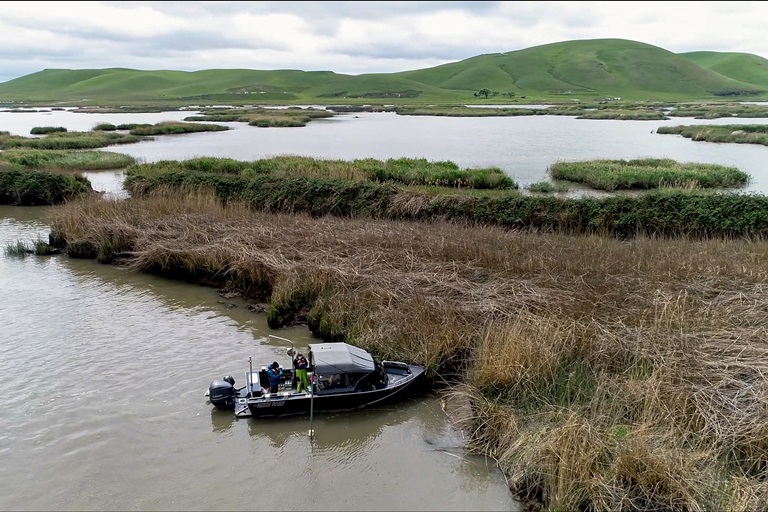DWR Completes Juvenile Salmon Habitat Study Amid COVID-19 Emergency
DWR researchers working on the Tidal Parr Cage Growth Study in the Suisun Marsh. DWR/2020
A study by the Department of Water Resources (DWR) investigating the growth rate of juvenile Chinook salmon raised in the Suisun Marsh area of Solano County was forced to conclude early due to the ongoing COVID-19 health emergency. Despite the change of plans, DWR scientists were still able to gather all pertinent data and are confident the study will provide useful information regarding how juvenile Chinook salmon grow.
“Originally the study was going to last eight or nine weeks,” said Brett Harvey, senior environmental scientist with DWR’s Division of Environmental Services (DES). “Two weeks into the 2020 study period COVID-19 protocols and guidelines went into effect and threw a real wrench in our plans.”
DWR’s Tidal Parr Cage Growth Study was meant to run from late February to mid-April in 2019 and 2020. Despite being forced to conclude the 2020 portion of the experiment early, DWR was able to collect key findings regarding how juvenile salmon grow in the brackish water habitats of a marsh.
“I think we might get some pretty good marsh habitat data this year,” Harvey said. “The biggest differences we saw in growth for 2019 occurred between week two and week six, and that’s the period we’ve just been through, even with COVID-19.”
The Tidal Parr Cage Growth Study was forced to adapt quickly to the COVID-19 emergency, with contracted crews going on voluntary self-quarantine in the weeks leading up to the final trip/mission/boat trip.
“Anyone that wanted to see our work come to a conclusion in April 2020 went on a three-week quarantine starting at the beginning of March originally just to play it safe,” said Harvey. “They stayed on quarantine for three weeks, and we set up crews of three people, with their own boat, that wouldn’t intermingle with any other crew members. They had their own equipment and followed all social distancing protocols on the boat.”
The Tidal Parr Cage Growth Study is seen as essential work due to its direct tie to DWR’s mission of sustainably managing the water resources of California, to benefit the state’s people and protect, restore, and enhance its natural and human environments.
“This information is really critical for informing actions and decisions for managing water and habitat restoration,” Harvey said. “We can plug this information into previous models and its really going to help us pinpoint and target the kinds of actions that we need to do to save the salmon population in our state.”
This study is a collaborative effort of DWR, UC Davis, NOAA Fisheries, and ICF, and is partially supported by grants from CDFW Prop 1 (184677), USBR-CVPIA (R18AP00148), Metropolitan (P89601300), and SFCWA.
